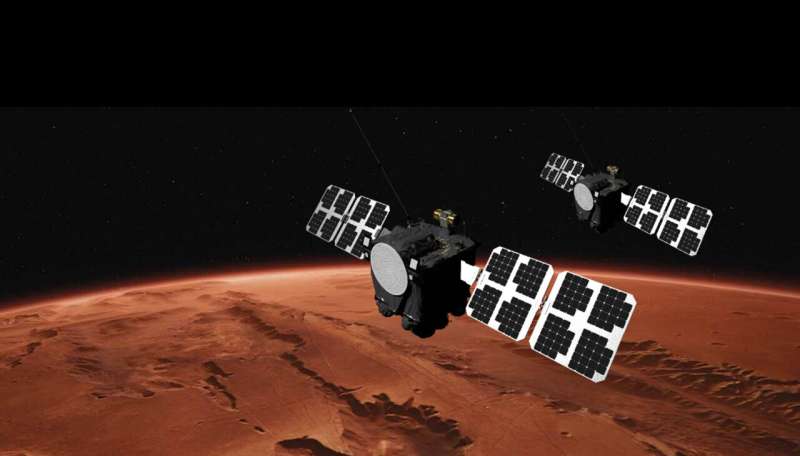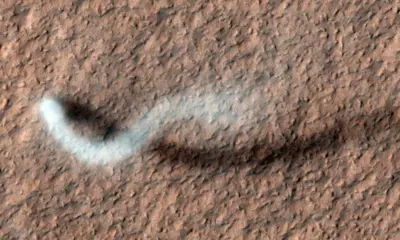Science
NASA Set to Launch Historic ESCAPADE Mission to Mars in November

NASA is preparing for the launch of its ESCAPADE mission, marking the first dual-satellite endeavor aimed at exploring Mars. The two identical satellites, named Blue and Gold, are scheduled to launch no earlier than November 9, 2025, from Cape Canaveral, Florida. Managed by the University of California, Berkeley, the mission aims to provide a 3D map of Mars’ magnetic fields, upper atmosphere, and ionosphere, offering crucial insights into the planet’s environmental conditions.
The ESCAPADE mission will help scientists understand the processes that led to Mars losing its atmosphere over billions of years. This information is vital for future human exploration, as it will inform potential colonization efforts. Principal investigator Robert Lillis of UC Berkeley’s Space Sciences Laboratory emphasized the importance of understanding ionospheric variations for accurate communication and navigation on Mars.
The twin satellites are expected to arrive at Mars in 2027. They will be operated from the Space Sciences Laboratory’s mission operations center in Berkeley. The scientific instruments and data processing systems were developed by UC Berkeley and its partners, while the spacecraft were constructed by Rocket Lab U.S. in Long Beach, California. The launch will be executed using a New Glenn rocket developed by Blue Origin.
Significance of the Mission
Mapping Mars’ magnetic fields and their interaction with space weather is essential, given that the planet lacks a global magnetic field and a thick atmosphere. This deficiency exposes the Martian surface to harmful solar radiation, which poses a risk to any potential human inhabitants. Lillis noted that background radiation from the Milky Way is always present on Mars, but significant solar storms can dramatically increase radiation levels. For instance, NASA’s Curiosity rover recorded a solar storm last year that delivered radiation equivalent to that of 100 days of normal background exposure in just one day.
As ESCAPADE embarks on its journey, it will also explore a new trajectory to Mars. Traditionally, Mars missions are launched during a narrow window every 26 months, adhering to an energy-efficient Hohmann Transfer orbit. In contrast, ESCAPADE will utilize a trajectory that first leads to a Lagrange point—a location where the gravitational forces of the Earth and Sun are balanced—before looping back toward Earth and then heading to Mars in November 2026. This innovative approach allows for greater flexibility in launch timing, which could be crucial for future missions.
Broader Implications and Scientific Goals
The dual-satellite configuration allows ESCAPADE to provide a stereo perspective of the Martian atmosphere, enabling scientists to monitor changes in real time. “This dual approach will help us characterize how the Martian atmosphere responds to solar wind on short timescales,” Lillis explained. Understanding this interaction is vital for comprehending Mars’ climatic evolution and the potential for water, which once existed in abundance on the planet.
ESCAPADE builds on nearly six decades of research conducted by UC Berkeley scientists on Mars. Previous missions, including NASA’s MAVEN, have demonstrated that Mars possesses localized magnetic fields created by its magnetized crust, remnants of a once global magnetic field. The data from ESCAPADE is expected to shed light on how solar activity influences atmospheric escape, contributing to a better understanding of the planet’s history.
While the mission is ambitious, Lillis recognizes the challenges of human settlement on Mars. The planet’s low atmospheric pressure and exposure to cosmic radiation present significant obstacles. Yet, he remains optimistic about humanity’s tenacity in overcoming these challenges.
In summary, NASA’s ESCAPADE mission represents a significant leap forward in our understanding of Mars and its environment. With its innovative trajectory and dual-satellite design, the mission is poised to revolutionize our knowledge of the Red Planet, paving the way for future exploration and eventual colonization efforts.
-

 Technology4 months ago
Technology4 months agoDiscover the Top 10 Calorie Counting Apps of 2025
-

 Health2 months ago
Health2 months agoBella Hadid Shares Health Update After Treatment for Lyme Disease
-

 Health3 months ago
Health3 months agoErin Bates Shares Recovery Update Following Sepsis Complications
-

 Technology4 weeks ago
Technology4 weeks agoDiscover 2025’s Top GPUs for Exceptional 4K Gaming Performance
-

 Technology2 months ago
Technology2 months agoElectric Moto Influencer Surronster Arrested in Tijuana
-

 Technology4 months ago
Technology4 months agoDiscover How to Reverse Image Search Using ChatGPT Effortlessly
-

 Technology4 months ago
Technology4 months agoMeta Initiates $60B AI Data Center Expansion, Starting in Ohio
-

 Technology4 months ago
Technology4 months agoRecovering a Suspended TikTok Account: A Step-by-Step Guide
-

 Health4 months ago
Health4 months agoTested: Rab Firewall Mountain Jacket Survives Harsh Conditions
-

 Lifestyle4 months ago
Lifestyle4 months agoBelton Family Reunites After Daughter Survives Hill Country Floods
-

 Technology3 months ago
Technology3 months agoUncovering the Top Five Most Challenging Motorcycles to Ride
-

 Technology4 months ago
Technology4 months agoHarmonic Launches AI Chatbot App to Transform Mathematical Reasoning




















